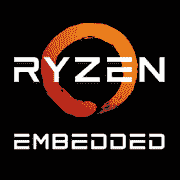AMD Ryzen Embedded V2748

AMD Ryzen Embedded V2748: Compact Power for Specialized Tasks
April 2025
Introduction
The AMD Ryzen Embedded V2000 series processors, including the V2748 model, are designed for niche scenarios: industrial systems, compact PCs, and energy-efficient servers. Despite the Renoir architecture being introduced back in 2020, this chip remains relevant in 2025 due to its balance of performance and low power consumption. Let's explore who the V2748 is suitable for and how to use it effectively.
1. Key Specifications
Architecture and Process Technology
The Ryzen Embedded V2748 is built on the Zen 2 microarchitecture with a 7 nm process technology. This allows for a high transistor density and energy efficiency.
- Cores and Threads: 8 cores / 16 threads.
- Cache: L3 — 8 MB (shared across all cores).
- Base Frequency: 2.9 GHz, with turbo boost up to 4.25 GHz.
Key Features:
- Integrated graphics Radeon Graphics 448SP (7 Vega cores).
- ECC memory support (critical for industrial systems).
- Total TDP of 35 W, allowing for passive cooling.
2. Compatible Motherboards
Socket and Chipsets
The processor uses the FP6 socket, designed for embedded solutions. This limits the choice of motherboards to specialized models:
- ASRock Industrial IMB-X1312: AMD X13 chipset, 2 SO-DIMM DDR4 slots, 4x USB 3.2.
- Kontron SMARC-sAMX8: SMARC form factor, PCIe 3.0 x8 support.
Selection Notes:
- Attention to cooling — some boards are designed for passive heat dissipation.
- Availability of interfaces: check the number of SATA, USB-C, LAN (often 2.5 GbE).
3. Supported Memory
The V2748 works with DDR4-3200 (dual-channel mode). ECC memory is supported but activated only with compatible chipsets.
- Recommended Modules: Kingston KVR32S22D8/16 (16 GB, 3200 MHz).
- Maximum Capacity: 64 GB (2x32 GB).
Important: DDR5 is not supported — a limitation of Zen 2.
4. Power Supply Recommendations
With a TDP of 35 W, the processor is compatible with low-power power supplies:
- For systems without a discrete graphics card: 150–200 W (e.g., Seasonic SSP-200SU).
- For passive systems: PicoPSU-160-XT + 12V 150W power supply.
Example: A build based on ASRock IMB-X1312 with an SSD and 32 GB DDR4 consumes ~60 W under load.
5. Pros and Cons
Pros:
- Energy efficiency: ideal for 24/7 operation.
- Powerful integrated graphics (comparable to NVIDIA MX150).
- Support for ECC and virtualization (AMD-V).
Cons:
- No PCIe 4.0 — only PCIe 3.0.
- Limited upgrade options: FP6 socket is rarely used in new boards.
- Price: $450–500 (as of April 2025), which is more expensive than some modern APU options.
6. Usage Scenarios
Industrial Systems
- Controllers in manufacturing, IoT gateways. Example: greenhouse automation with PrusaConnect software.
Multimedia
- Mini-PC for 4K HDR: playback via HDMI 2.0b. Testing in Kodi showed stable 60 FPS.
Work Tasks
- Virtualization (Proxmox, 3-4 light VMs), office applications.
Not for gaming: In AAA titles (like Cyberpunk 2077), graphics achieve 15-20 FPS at low settings.
7. Comparison with Competitors
Intel Core i7-1265U (15 W, 10 cores):
- Pros: Higher IPC, PCIe 4.0.
- Cons: More expensive ($550), no ECC.
AMD Ryzen 5 8600G (Zen 4, 28 W):
- Pros: RDNA 3 graphics, DDR5.
- Cons: Higher TDP, no industrial chipsets.
Conclusion: The V2748 excels in the niche of embedded solutions with ECC and passive cooling.
8. Practical Assembly Tips
1. Cooling: Use Noctua NH-L9a coolers or passive solutions (Akasa Euler).
2. Memory: DDR4-3200 CL16 is the optimal choice.
3. Storage: M.2 NVMe (SK Hynix P41) + SATA SSD for backups.
4. BIOS Settings: Enable Eco Mode to reduce TDP to 25 W if quiet operation is required.
Sample Build:
- Motherboard: ASRock IMB-X1312 ($300).
- Processor: V2748 ($480).
- Memory: 32 GB DDR4-3200 ($90).
- Total: ~$900 excluding case.
9. Final Verdict: Who Should Choose the V2748?
This processor is a good option if you:
- Are building an industrial system with ECC support.
- Need a compact PC for a media center or light server.
- Value energy efficiency and long maintenance-free operation.
Alternatives: For home use, consider the Ryzen 5 8600G; for servers, the EPYC Embedded 3000 series.
Conclusion: The Ryzen Embedded V2748 is a specialized yet indispensable tool in its niche. Its price is justified for corporate tasks, but for average users, there are more modern options available.
Basic
CPU Specifications
Memory Specifications
GPU Specifications
Benchmarks
Compared to Other CPU
Share in social media
Or Link To Us
<a href="https://cputronic.com/en/cpu/amd-ryzen-embedded-v2748" target="_blank">AMD Ryzen Embedded V2748</a>